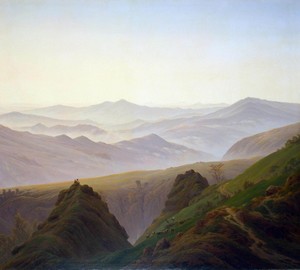
Description of the picture:
Morning in the mountains – Caspar David Friedrich. 1822-1823. Canvas, oil. 137 x 170 cm
Undoubtedly, romantic artists brought even more beauty, emotions, freedom and feelings to painting. This can be seen by looking at the picture of the German artist, the brightest representative of the romantic direction, Caspar David Friedrich “Morning in the Mountains.”
The painter takes the viewer to a certain nominal high point, from where amazing views of the mountain peaks open. The sloping peaks of the mountains are like sea waves, frozen in time, covered with soft clouds of predawn thick fog. Frederick maintains the realism of time and place. That is how a person should feel in a fog – it’s just not visible at the feet of his fog, and you need to look a little further away to notice this atmospheric phenomenon. Moreover, the master very likely portrayed the fog in the mountains – as if from a gentle edge it rolls down, filling all the space at the foot.
The unsteady moment is reproduced on the canvas – the sun is about to rise, and you can notice the reflection of its rays at the horizon beyond the central mountain peak. The sky with its subtlest transitions from blue to white, ocher, golden and pink makes us remember the impressionists. Of course, romantics anticipated the work of artists “impressions”.
You can see that the picture does not have the usual hero standing with his back (leitmotif reception by Caspar David Friedrich). The author intentionally refuses it, giving us more “independence”. The viewer is not constrained by the image of the hero – he is excited, philosophical, focused or peaceful. Now the viewer himself, whatever he may be, can be transported to the top of the mountains to enjoy the dawn grace.
The narrative of the picture is achieved by filigree coloristics – there is no dynamic plot, catchy contrasting elements, unexpected twists, but smooth transitions of colors, designed to paint the image, make you examine the picture carefully and slowly. Near this work, you can stand a significant amount of time.
For the Russian audience, the magical painting by Caspar Friedrich is more than accessible – it can be seen in the Hermitage, where the canvas is exhibited in a hall dedicated to German fine art. She got to one of the main museums in the country from Pavlovsk, where she was kept in storage during the Great Patriotic War."